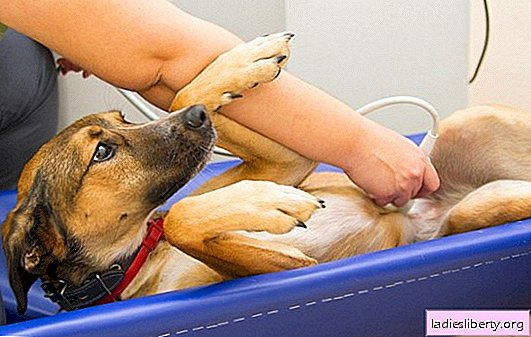
The main sign of a hernia in dogs is prolapse of the internal organs with a protrusion of the skin in this area. There are several varieties of this pathology in animals, from which not a single representative of the canine genus is insured. For this reason, you should arm yourself with information about their symptoms and treatment.
Types of hernia
Hernias, by origin, are congenital or acquired. In dogs, as a rule, the following types of hernias predominate:
1. In the esophagus - hiatal.
2. Between the bladder and the rectum - perineal.
3. Around the navel is umbilical.
4. On the back wall of the abdominal cavity is - inguinal.
5. In the area of the diaphragm is located - the diaphragm.
6. Between the dorsal vertebrae - the intervertebral.
Perineal hernia in dogs
It is formed as a result of prolapse of the pelvic organs: intestines, uterus, omentum, bladder. A neoplasm is very dangerous for pregnant dogs. With the rupture of the precipitated organs, severe peritonitis appears, a deadly disease. The crotch type is characterized by the formation of a large tumor, soft, rolling when the dog moves. The main cause of perineal hernia is mechanical damage.
Umbilical hernia
It is often found in only born puppies. Internal organs descend into the umbilical ring, in connection with which, a round swelling appears. Adult animals can acquire this hernia due to high intra-abdominal pressure, persistent constipation, after childbirth, trauma, flatulence, cramping. Such a disease is determined quite easily visually. On the abdomen in dogs, a roundish lump is formed, covered in skin. It happens in different sizes from a couple of millimeters to several centimeters.
The first signs of an umbilical hernia are: pain when pressed, loss of appetite, weakened and depressed state, rapid pulse.
Types of umbilical hernia:
1. False - a soft round neoplasm near the navel straightens when pressed;
2. True - is formed in a hernial sac;
3. Directed - with a certain pressure, such a hernia will return to its original state;
4. Not adjustable - the organ that has fallen is clamped by the umbilical ring and increases
True hernia is a very dangerous disease. Emergency medical advice is needed. Such a hernia is easily treatable in puppies.
What should be done if there is a suspicion of an umbilical hernia in a dog? Need an examination in a veterinary clinic. Having examined and probed, the veterinarian establishes the dimensions of the hernial ring, its content and mobility. Such a procedure can help determine the degree of progression of this disease and prescribe the appropriate treatment.
Small hernias can cause complications. If there is the slightest possibility of prolapse of the internal organs into the hernia gate, then surgical intervention is necessary
In already adult animals, hernia removal is only possible by surgery.
After the operation, the four-legged friend needs additional care. The veterinarian is prescribed treatment and a course of injections with antibiotics. On the first day after surgery, the dog will be lethargic and sleep all the time. As the seam overgrows, the animal will become more active.
After treatment of this hernia, animals must be sterilized, since this disease is hereditary.
Inguinal hernia
More often inguinal hernia is found in females; the bladder, intestines or uterus will fall out. The disease can cause intrauterine pressure.
The contents of this type of hernia is irreducible and correctable.
After setting, the pet needs to be given time to rest, but most often the animal is immediately ready for active pastime.
Diaphragmatic hernia in dogs
Appears when the abdominal organs move to the chest. Most often, such organs fall out: intestines, spleen, liver. There is a divergence of the diaphragm in the weakest area.
Usobak diaphragmatic hernia can be congenital (non-traumatic) or acquired (traumatic).
The causes of congenital disease are defects of the abdominal and chest areas. The most common type of congenital hernia is a violation of the food opening of the diaphragm. Part of the esophagus and stomach moves to the chest.
The causes of a hernia of an acquired nature can be any damage: fall, shock, injury, intrauterine pressure.
To accurately diagnose, you need to do an x-ray and an ultrasound of the chest and abdominal organs. If the diagnosis is confirmed, surgery will be necessary.
Intervertebral hernia
Due to large overloads of the back, displacement of the intervertebral discs occurs. In this case, it is necessary to understand how much the spinal cord of the animal is damaged. It is possible to determine the presence of a vertebral hernia by the behavior of the dog. Slow, inhibited movements, tension of the back muscles, difficulty in bending the head speak of the disease.
This type of disease is considered the most dangerous, can lead to paralysis of the animal. If there is a suggestion for an intervertebral hernia, you should contact the veterinary hospital as soon as possible. The veterinarian will conduct a full examination, x-ray the spine. Based on the information received, the veterinarian prescribes treatment. With a mild displacement of the intervertebral discs, anti-inflammatory drugs are prescribed. If the disease is started, an emergency operation is needed.











